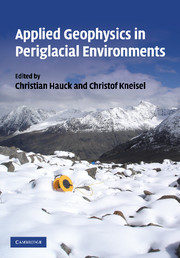Book contents
- Frontmatter
- Contents
- List of contributors
- Introduction
- Part I Geophysical methods
- Part II Case studies
- 5 Typology of vertical electrical soundings for permafrost/ground ice investigation in the forefields of small alpine glaciers
- 6 ERT imaging for frozen ground detection
- 7 Electrical resistivity values of frozen soil from VES and TEM field observations and laboratory experiments
- 8 Results of geophysical surveys on Kasprowy Wierch, the Tatra Mountains, Poland
- 9 Reassessment of DC resistivity in rock glaciers by comparing with P-wave velocity: a case study in the Swiss Alps
- 10 Quantifying the ice content in low-altitude scree slopes using geophysical methods
- 11 The use of GPR in determining talus thickness and talus structure
- 12 GPR soundings of rock glaciers on Svalbard
- 13 Arctic glaciers and ground-penetrating radar. Case study: Stagnation Glacier, Bylot Island, Canada
- 14 Mapping of subglacial topography using GPR for determining subglacial hydraulic conditions
- 15 Snow measurements using GPR: example from Amundsenisen, Svalbard
- 16 Mapping frazil ice conditions in rivers using ground penetrating radar
- Appendix: Tables of geophysical parameters for periglacial environments
- Index
- Plate section
- References
15 - Snow measurements using GPR: example from Amundsenisen, Svalbard
Published online by Cambridge University Press: 22 August 2009
- Frontmatter
- Contents
- List of contributors
- Introduction
- Part I Geophysical methods
- Part II Case studies
- 5 Typology of vertical electrical soundings for permafrost/ground ice investigation in the forefields of small alpine glaciers
- 6 ERT imaging for frozen ground detection
- 7 Electrical resistivity values of frozen soil from VES and TEM field observations and laboratory experiments
- 8 Results of geophysical surveys on Kasprowy Wierch, the Tatra Mountains, Poland
- 9 Reassessment of DC resistivity in rock glaciers by comparing with P-wave velocity: a case study in the Swiss Alps
- 10 Quantifying the ice content in low-altitude scree slopes using geophysical methods
- 11 The use of GPR in determining talus thickness and talus structure
- 12 GPR soundings of rock glaciers on Svalbard
- 13 Arctic glaciers and ground-penetrating radar. Case study: Stagnation Glacier, Bylot Island, Canada
- 14 Mapping of subglacial topography using GPR for determining subglacial hydraulic conditions
- 15 Snow measurements using GPR: example from Amundsenisen, Svalbard
- 16 Mapping frazil ice conditions in rivers using ground penetrating radar
- Appendix: Tables of geophysical parameters for periglacial environments
- Index
- Plate section
- References
Summary
Introduction
Snow distribution in mid- and high-latitude landscapes plays a key role in defining energy and moisture relationships associated with earth's climate system. The spatial distribution of snow is critical for accurate assessment and forecasting of snowmelt timing (Luce et al. 1998), snowmelt volume (Elder et al. 1991), avalanche hazard (Birkeland et al. 1995, Conway and Abrahamson 1984) and glacier mass balance modelling (e.g. Schuler et al. 2007) for initialisation of synoptic- and global-scale weather and climate models (Liston 1999). Traditional areal snow surveys are typically performed along lines, where snow depth measurements are done with graduated rods and snow density samples taken with a snow tube. Those methods are very time consuming and laborious and thus costly. Over the past decades, there has been a growing interest in looking at and developing new less time-consuming methods. Pomeroy and Gray (1995) gives a description of several of these methods.
The ground penetrating radar (GPR) technique for snow measurements has been developed over the past two or three decades (Annan et al. 1994, Ellerbruch and Boyne 1980, Kohler et al. 1997), but only recently have operational routines been established for using GPR in snow surveying (e.g. Marchand et al. 2001, Sand and Bruland 1998) and for snow distribution mapping on Svalbard glaciers (Sand et al. 2003, Taurisano et al. 2007, Winther et al. 1998). Snow depth is measured indirectly using GPR systems, also called georadar or snowradar since electromagnetic (micro) waves can easily penetrate ice and snow.
- Type
- Chapter
- Information
- Applied Geophysics in Periglacial Environments , pp. 207 - 216Publisher: Cambridge University PressPrint publication year: 2008
References
- 1
- Cited by



